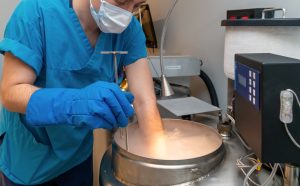A new approach to treating heel pain
Plaguing 15% of individuals seeking medical attention for foot discomfort, plantar fasciitis is the leading culprit behind heel pain worldwide. This condition does not merely disrupt a person’s ability to walk without pain, it can lead to complications such as weight gain and emotional distress due to reduced mobility.
However, hope glimmers on the horizon with a breakthrough procedure known as autologous fat grafting (AFG), a minimally invasive treatment showing promising results in alleviating this chronic pain.
What is Plantar Fasciitis?
Plantar fasciitis commonly manifests as inflammation in the plantar fascia, a thick tissue band spanning the bottom of your foot, linking your heel bone to your toes.
This condition frequently results in heel pain and discomfort, typically appearing with the initial steps after waking up or upon standing following a period of rest. Runners, overweight individuals, and those who wear shoes lacking adequate support are the usual sufferers of this condition.
The pain is caused by inflammation or degeneration of the plantar fascia due to strain and stress over time. Despite being a prevalent foot disorder, it is treatable with a combination of rest, physical therapy, anti-inflammatory drugs, autologous fat grafting, and in some cases, surgery.
How Does AFG Work?
Autologous fat grafting, or AFG, may sound complex, but the concept behind the procedure is relatively straightforward. Essentially, it involves harvesting fat from one area of a patient’s body, purifying it, and then injecting this processed fat into the painful heel area.
The injected fat acts like a cushion, mitigating plantar pressure and, as a result, easing heel pain. Consider the case of a 72-year-old man who had been grappling with plantar fasciitis for five years. After exhausting other treatment avenues without success, he opted for AFG. The result? A significant drop in pain levels and enhanced foot functionality.
The Procedure in Detail
The journey to relief begins with a liposuction procedure. Fat is carefully extracted from the patient’s abdomen and then subjected to a purification process. Once purified, the fat is then injected into the foot at the site of the plantar fascia. This entire process is minimally invasive, reducing the risk of scar tissue formation or disruptions to foot biomechanics.
Challenges with AFG
Like any medical procedure, AFG is not without its challenges. There may be variations in fat resorption rates from patient to patient, which could potentially impact the long-term effectiveness of the treatment. However, the immediate relief experienced post-procedure could offset these potential drawbacks.
Other Treatment Methods for Plantar Fasciitis
Aside from rest, physical therapy, anti-inflammatory drugs, and surgery, there are several other methods used in the treatment of plantar fasciitis.
- Orthotics and Supports: Custom orthotics, or over-the-counter arch supports and heel cushions, can be beneficial. These devices can help distribute pressure evenly on your feet when you move, reducing the strain on the plantar fascia.
- Night Splints: These devices stretch your calf and the arch of your foot while you sleep. This can help lengthen the arch and plantar fascia and decrease morning stiffness and pain.
- Extracorporeal Shock Wave Therapy: This method involves directing sound waves into the heel to stimulate healing within the affected area. It is used for chronic plantar fasciitis that has not responded to more conservative treatments.
- Steroid Injections: Injecting a type of steroid medication into the painful area can provide temporary pain relief. This is not usually a first-line treatment due to potential side effects such as weakening or rupture of the plantar fascia.
- Tenex Procedure: This minimally invasive treatment involves removing scar tissue caused by plantar fasciitis without surgery. Ultrasound imaging is used to identify the damaged tissue, which is then removed with a small instrument.
While these treatments can provide relief, they may not work for everyone. Treatment plans can vary depending on the individual’s specific needs and the severity of the condition.
Key Takeaways
Autologous fat grafting holds great promise as a potential treatment option for individuals suffering from the debilitating effects of plantar fasciitis.
Although variable fat resorption rates might pose some limitations, we cannot ignore the immediate pain relief and enhancements in overall quality of life that this procedure provides. These findings indicate the significant potential of autologous fat grafting in reducing plantar fasciitis symptoms, underscoring the need for further exploration of this treatment option.
References:
- Phan, K., & Lin, M. J. (n.d.). Autologous Fat Grafting for Plantar Fasciitis. PubMed Central (PMC). https://doi.org/10.4103/JCAS.JCAS_206_20
- C. (n.d.). Plantar Fasciitis: Symptoms, Causes & Treatment Options. Cleveland Clinic. https://my.clevelandclinic.org/health/diseases/14709-plantar-fasciitis
- Plantar Fasciitis – Harvard Health. (2020, February 24). Harvard Health. https://www.health.harvard.edu/a_to_z/plantar-fasciitis-a-to-z
- Plantar Fasciitis and Bone Spurs – OrthoInfo – AAOS. (2022, August 1). Plantar Fasciitis and Bone Spurs – OrthoInfo – AAOS. https://www.orthoinfo.org/en/diseases–conditions/plantar-fasciitis-and-bone-spurs/













